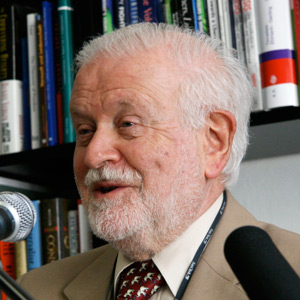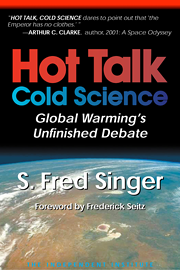In discussing the recent release of some 5,000 Climategate e-mails, blogger Anthony Watts uses the clever headline “They are real—and they’re spectacular.” He credits Jerry Seinfeld as the source. Following his example, I choose the headline “Fake! Fake! Fake! Fake!”—also taken from a Seinfeld episode—in discussing the surface temperatures generally reported for the latter part of the 20th century; they form the science basis for prosperity-killing international climate policy.
Here I am using the word “fake” as an adjective, and not as a verb. I mean to say that the scientific conclusions derived from such temperatures are not real, but I don’t imply that the values themselves have been purposefully altered or adjusted. We simply don’t have any information to support such an accusation.
But I do claim that the commonly reported and accepted warming between 1978 and 2000 is based only on thermometers from land surface stations and is not supported by any other evidence that I could find. Specifically, ocean data (from 71% of the earth’s surface) and global atmospheric data (as recorded by satellites and independent balloon-borne radiosondes) do not show such a warming at all. In addition, most proxy data, from non-thermometer sources such as tree rings, ocean sediments, ice cores, stalagmites, etc., show no warming during this same crucial period. (One has to be careful in this analysis since the year 1998 shows a major warming spike caused by a Super-El Niño. But by 1999 and 2000, temperatures had returned to pre-1998 values.)
Now, I am well aware of the fact that the recent release of the temperature data from the Berkeley Earth Surface Temperature (BEST) project does show a warming trend from 1978 to 2000. Many would jump to the conclusion that this represents confirmation of the existence of global warming—or even of anthropogenic global warming (AGW). However, that would be an error in logic.
What the BEST result shows is that surface thermometers from the land area of the globe (about 29% of the earth’s surface) show a warming trend. But this is not global warming. And BEST director Professor Rich Muller explicitly disclaims that his trend results indicate a human cause.
He also correctly points out that many of the weather stations used are badly distributed, mostly in the U.S. and western Europe, and possibly subject to local heating effects, such as urban heat islands. He cautions that a third of his monitoring stations show a cooling, not a warming. And that 70% of the U.S. stations are poorly situated and don’t satisfy the requirements of the U.S. Weather Service. It is likely that stations elsewhere have similar problems.
While we can applaud the fact that the BEST results agree with other analyses of weather station data, we still need to explain why they don’t agree with atmospheric trends that are close to zero, or with ocean data that show no appreciable warming.
As a first step, the BEST data are ideally suited for a number of internal checks. For example, one would like to see if the number of stations changed appreciably between 1970 and 2000, and if their “demographics” changed—which might lead to the formation of artificial trends.
There are many other such tests that can be performed. They might help us discover why land surface data disagree with all other data; thereby, we may get a better handle on whether the planet is really warming. We note here that the BEST results do not show any warming trend in the 21st century—even though carbon dioxide levels have been rising more rapidly than before.
Note again: Professor Muller and his colleagues do not claim that their results indicate a human source for warming—unlike the IPCC, the U.N. Science Panel, which has claimed to be 90-99% sure that the late-20th century warming is anthropogenic. But if there is no warming between 1978 and 2000, then IPCC’s case collapses—and so do all policies built on the IPCC conclusion.
But this whole matter has really moved beyond any academic discussion. Industrialized nations that signed the Kyoto Protocol (including the U.S., which did not ratify) have already wasted hundreds of billions of dollars on policies based on the acceptance of the IPCC claim that greenhouse gases (mainly carbon dioxide from the burning of oil, gas, and coal) are responsible for a reported warming—which may not even exist.
(By now it should be obvious that [1] the enshrined temperature limit of +2 deg C [beyond which climate disasters are supposed to set in] is based on fiction and has no scientific basis. As an annual global average temperature, so climate models tell us, it would mean warmer winter nights in Siberia and Canada—perhaps -35 degrees instead of -40—and little warming in the tropics. [2] It should also be obvious that even strenuous and economy-killing efforts at mitigation will have little effect on atmospheric levels of carbon dioxide, let alone on climate. If a demonstration is needed, just look at the lack of warming since 1998, in spite of rapidly rising levels of greenhouse gases.)
As is evident from the Climategate e-mails, a small group of scientists, mainly in the U.K. and U.S., have managed to freeze out contrary evidence from being published in the scientific literature or in IPCC reports. The self-described “Team” members brazenly discuss strategies and action plans to further “The Cause.” Unfortunately, they have largely succeeded—and continue to influence publications, thanks to some key journalists and editors. In consequence of this evident conspiracy, it is hardly surprising that politicians, the media, and the general public are receiving entirely wrong information about supposedly catastrophic effects of a future warming.
The just-concluded Durban conference, the 17th in an annual series, demonstrates clearly that the whole discussion is no longer about science, but instead is all about money. (1) How to assure continuing government careers for nearly 200 delegations, with annual vacations paid by taxpayers. (2) How to transfer $100 billion a year from industrialized nations to LDCs (or more precisely, to their kleptocratic rulers), using “climate justice” or "climate guilt" (depending on who is doing the talking). (3) How to gain a national advantage by setting differential emission limits of CO2—supposedly to keep the planet from reaching a “dangerous” level of warming.
Durban did succeed in extending Kyoto till 2015—presumably to allow time to fashion a successor protocol to include all nations. But it is a hollow victory. Russia and Japan have already announced that they are not continuing—and Canada is formally withdrawing from Kyoto. In the U.S., the White House has never submitted Kyoto to the Democrat-controlled Senate for ratification. Instead, as promised, Obama is using indirect ways to "skin the cat" and make "electricity prices skyrocket”—relying on EPA regulations to destroy domestic coal as a boiler fuel.
Yet hope springs eternal in the hearts of true warmistas that China, by far the largest emitter of carbon dioxide, will join a future protocol in 2015. In Durban, China’s chief climate negotiator Xie Zhen Hua dropped all kinds of hints that China might be willing to join a second commitment period of emission targets—provided certain conditions are met. Not surprisingly, a number of environmental activists have taken the bait and really believe that China is willing to sacrifice economic growth to satisfy the elusive goal of controlling global warming.
Within the United States, and also elsewhere, global warming scares have become a means of transferring taxpayer money to politically influential cronies. There is now so much “crony capitalism” that it would be difficult to reverse or even stop the ongoing subsidies, outright grants, tax breaks, and other transfers to privileged groups.
Time is becoming short. We’re reaching a tipping point—not of the earth’s climate, but of the financial schemes that permanently divert funds from productive activities into wasteful ones, all in the name of “saving the climate.” The results are evident: higher levels of spending, deficits, or taxes; higher prices for energy and electricity and therefore for all manufactured goods; less productive activity; less employment; and more misery.
It seems odd that all of this is essentially based on a fake—the data that seem to show a (nonexistent) warming. It will be difficult to overturn this notion, but we must keep trying.









